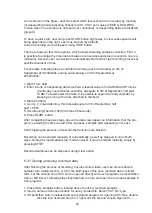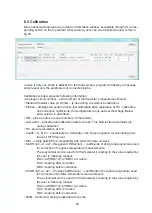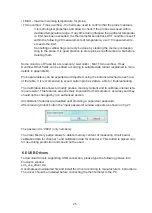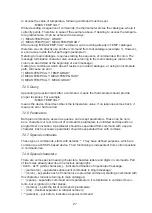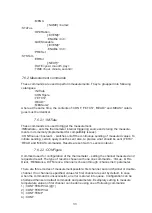
35
7.6.2.5 :MEASure?
This command is used for configuration and execution of measurement, including returning
of the result. It can be treated as equal to sending:
1) :CONFigure:...
2) :READ?
commands.
Method of measurement configuration is identical as in case of :CONFigure command.
7.6.3 :UNIT – measurement’s units handling
The command is used for setting and checking the temperature units used for displaying
and calculations. Using :TEMP sub-command actual temperature unit can be set. Three
basic temperature scales have been implemented into the thermometer: Celsius, Kelvin,
Fahrenheit. The thermometer can display results and receive data from the user in units
that are common with actual chosen scale. To switch between the scales mnemonic of
desired scale should be send as a command’s parameter:
• C or CEL – Celsius scale,
• K – Kelvin scale,
• F or FAR – Fahrenheit scale.
For example, setting Kelvin scale can go as follows:
:UNIT:TEMP K
Sending a query for this command will result in sending name of a presently used scale.
After switching off, the thermometer stores scale that had been used recently.
7.6.4 :INPut – measurement circuit configuration
The file contains only one command used for changing between 50Hz and 60Hz line
frequency rejection.
7.6.4.1 :FILTer – configuration of line frequency filter
The command changes sampling frequency of internal analog-to-digital converter in order
to get better 50Hz or 60Hz line frequency rejection. The subcommand :NOTCh is used
to type proper frequency. In case of typing values other than 50 or 60 the thermometer
communicates an error.
For example, setting rejection frequency of 50 Hz can go as follows:
:INP:FILT:NOTC 50
After switching off the thermometer stores rejection frequency that had been used recently.
7.6.5 :SENSe – configuration of measurement’s parameters
This catalogue contains a set of commands used for setting up the measurement. Only
one command however is implemented by thermometer.
7.6.5.1 :AVERage – measurement averaging
Following command is used for setting the amout of averaged measurement cycles, which
Summary of Contents for LDT 2000
Page 1: ...1 LDT 2000 PRECISION THERMOMETER MANUAL...
Page 14: ...14 5 Typical performance of the thermometer...
Page 15: ...15...
Page 16: ...16...
Page 17: ...17...
Page 43: ......
Page 44: ......


